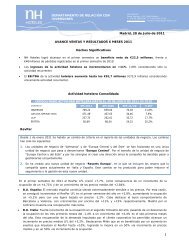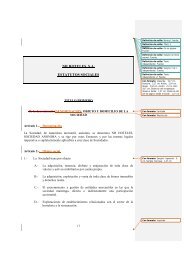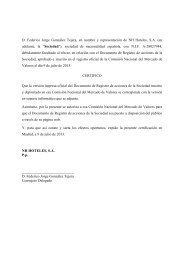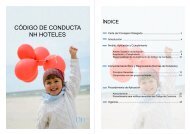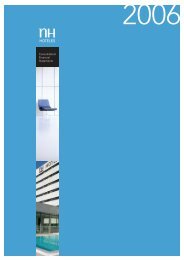Download Complete PDF - Informe Anual 2012
Download Complete PDF - Informe Anual 2012
Download Complete PDF - Informe Anual 2012
You also want an ePaper? Increase the reach of your titles
YUMPU automatically turns print PDFs into web optimized ePapers that Google loves.
4.12 Official subsidies<br />
Group companies follow the criteria set out below to book official subsidies:<br />
- Non-reimbursable capital subsidies (connected with assets) are valued at the amount granted, booked as deferred income and attributed to<br />
results in proportion to the depreciation of the assets financed by such subsidies during the financial year.<br />
- Operating subsidies are booked as income at the moment of their accrual.<br />
4.13 Tax on profits<br />
The cost of the year’s income tax is calculated through the sum of the current tax resulting from applying the tax rate to the taxable income for<br />
the year and then applying the relevant tax adjustments according to the law plus any changes in deferred tax assets and liabilities.<br />
Deferred tax assets and liabilities include temporary differences, being any amounts expected to be payable or recoverable due to differences<br />
between the book values of the assets and liabilities and their tax value, as well as the tax losses carryforward and any credits resulting from<br />
unapplied tax relieves. Said amounts are booked by applying to the relevant temporary difference or credit the tax rate at which they are<br />
expected to be recovered or settled.<br />
In some countries, the tax rate varies depending on whether a transfer of assets is made. In these cases, the Group’s policy consists of applying<br />
the effective tax rate at which they are expected to be recovered or settled. In the opinion of the Directors of the Group, the deferred tax thus<br />
calculated covers the amount which may eventually be settled, if any, in the foregoing case.<br />
Deferred tax liabilities for all taxable temporary differences are recognised, except for those in which the temporary difference arises from the<br />
initial recognition of goodwill whose depreciation may not be deducted for tax purposes or the initial recognition of other operating assets<br />
and liabilities which do not affect either the tax or accounting result.<br />
Deferred tax assets identified as temporary differences, meanwhile, are only recognised if it is deemed probable that the consolidated entities<br />
will make sufficient tax profits in the future to make them effective and they do not come from the initial recognition of other assets and<br />
liabilities in a transaction which does not affect either the tax or accounting result. Other deferred tax asset (tax losses carryforward and tax<br />
credits) are only recognised if it is likely that the consolidated companies will make sufficient tax profits in the future to make them effective.<br />
At each year-end, deferred taxes (both assets and liabilities) are reviewed in order to verify that they remain in force and the relevant corrections<br />
are made in accordance with the outcome of the analyses conducted.<br />
4.14 Undertakings made to the personnel<br />
Spanish hotel companies are obliged to make a specific number of monthly salary payments to those employees who leave the company due to<br />
retirement, permanent incapacity to work or upon reaching a certain age, as well as to those who have attained a certain level of seniority and<br />
fulfilled certain pre-established requirements.<br />
The liabilities accrued for these obligations are booked under the “Provisions for liabilities and charges” item of the consolidated balance sheet<br />
attached (see Note 21).<br />
In accordance with Royal Decree Law 16/2005, the Group has outsourced the above-mentioned undertakings, financing all the services accrued<br />
in advance.<br />
In accordance with prevailing Italian legislation, the employees of the subsidiary company Donnafugata Resort S.r.l. are entitled to compensation<br />
should they voluntarily leave the company or be dismissed. The “Non-current provisions” item of the consolidated balance sheet attached hereto<br />
includes the liabilities accrued for this item, which amounted to €193,000 at 31 December <strong>2012</strong> (€200,000 in 2011).<br />
4.15 Onerous agreements<br />
The Group considers onerous agreements to be those in which the inevitable costs of fulfilling the obligations they entail exceed the economic<br />
benefits expected from them.<br />
The Group follows the principle of recording a provision at the present value of the aforementioned differences between the costs and benefits<br />
of the contract, or the compensation foreseen for abandonment of the contract, if such is decided.<br />
The pre-tax discount rates used reflect the current market value of money, as well as the specific risks associated with these agreements. More<br />
specifically, a rate of between 7.42% and 12% has been used.<br />
4.16 Share-based remuneration schemes<br />
These schemes are valued at the time of granting, using a financial method based on a binomial model which takes into consideration the strike<br />
price, volatility, the exercise period, the expected dividends, the risk-free interest rate and the hypotheses made concerning the financial year.<br />
In accordance with IFRS 2, above-mentioned valuation is attributed to profit or loss under personnel expenses during the period established<br />
for the employee to remain in the company before exercising the option. This value is imputed on a straight-line basis to the consolidated<br />
comprehensive profit and loss statement from the date the scheme was implemented to the exercise date. As set forth in the Rules of the<br />
Scheme, settlement is to be made in cash. Therefore, the valuation obtained is recognised with a counter liability in favour of employees.<br />
Furthermore, the Group re-estimates the initial valuation mentioned above every year by recognising in the year’s profit or loss both the part<br />
corresponding to the year in question and those corresponding to previous years.<br />
Subsequently, the difference between the settlement and the recognised liability, as described above, for any transactions settled is booked<br />
in the consolidated comprehensive profit and loss statement once the required permanence period has transpired. Ongoing transactions at<br />
76 REPORT ON THE CONSOLIDATED FINANCIAL STATEMENTS



